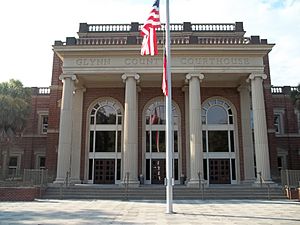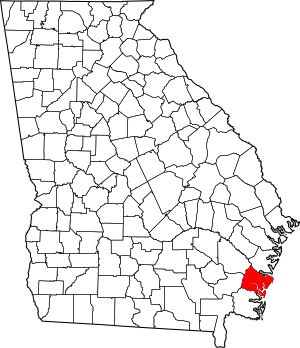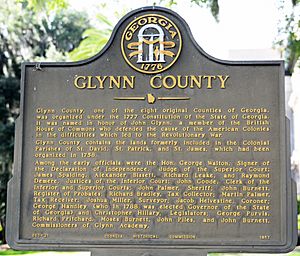Glynn County, Georgia facts for kids
Quick facts for kids
Glynn County
|
|
|---|---|

Glynn County Courthouse
|
|

Location within the U.S. state of Georgia
|
|
 Georgia's location within the U.S. |
|
| Country | |
| State | |
| Founded | 1777 |
| Named for | John Glynn |
| Seat | Brunswick |
| Largest city | Brunswick |
| Area | |
| • Total | 585 sq mi (1,520 km2) |
| • Land | 420 sq mi (1,100 km2) |
| • Water | 165 sq mi (430 km2) 28.3%% |
| Population | |
| • Estimate
(2019)
|
85,292 |
| • Density | 190/sq mi (70/km2) |
| Time zone | UTC−5 (Eastern) |
| • Summer (DST) | UTC−4 (EDT) |
| Congressional district | 1st |
Glynn County is located in the southeastern part of the U.S. state of Georgia. As of the 2010 census, the population was 79,626. The county seat is Brunswick. Glynn County is part of the Brunswick, Georgia Metropolitan Statistical Area.
Contents
History
Glynn County, one of the original eight counties in the state created on February 5, 1777, was named after John Glynn, a member of the British House of Commons who defended the cause of the American Colonies before the American Revolution.The Battle of Bloody Marsh was fought in Glynn County. James Oglethorpe built Fort Frederica which was used a base in the American Revolutionary War. Glynn Academy is the second oldest school in Georgia.
Glynn County includes the most prominent of the Sea Islands of Georgia, including Jekyll Island, St. Simons Island, and Sea Island. The Georgia poet Sidney Lanier immortalized the seacoast there in his poem, "The Marshes of Glynn", which begins:
- Glooms of the live-oaks, beautiful-braided and woven
- With intricate shades of the vines that myriad-cloven
- Clamber the forks of the multiform boughs,--
- Emerald twilights,--
- Virginal shy lights,
- Wrought of the leaves to allure to the whisper of vows,
- When lovers pace timidly down through the green colonnades
- Of the dim sweet woods, of the dear dark woods,
- Of the heavenly woods and glades,
- That run to the radiant marginal sand-beach within
- The wide sea-marshes of Glynn;--
The former Glynco Naval Air Station, named for the county, was a major base for blimps and anti-submarine warfare during World War II. The Federal Law Enforcement Training Center (FLETC) now uses a substantial part of the former NAS as its main campus.
Geography
According to the U.S. Census Bureau, the county has a total area of 585 square miles (1,520 km2), of which 420 square miles (1,100 km2) is land and 165 square miles (430 km2) (28.3%) is water.
The majority of Glynn County is located in the Cumberland-St. Simons sub-basin of the St. Marys-Satilla River basin. Most of the county's northern and northwestern border area is located in the Altamaha River sub-basin of the basin by the same name.
Major highways
Adjacent counties
- McIntosh County - north
- Camden County - southwest
- Brantley County - west
- Wayne County - northwest
Demographics
| Historical population | |||
|---|---|---|---|
| Census | Pop. | %± | |
| 1790 | 413 | — | |
| 1800 | 1,874 | 353.8% | |
| 1810 | 3,417 | 82.3% | |
| 1820 | 3,418 | 0.0% | |
| 1830 | 4,567 | 33.6% | |
| 1840 | 5,302 | 16.1% | |
| 1850 | 4,933 | −7.0% | |
| 1860 | 3,889 | −21.2% | |
| 1870 | 5,376 | 38.2% | |
| 1880 | 6,497 | 20.9% | |
| 1890 | 13,420 | 106.6% | |
| 1900 | 14,317 | 6.7% | |
| 1910 | 15,720 | 9.8% | |
| 1920 | 19,370 | 23.2% | |
| 1930 | 19,400 | 0.2% | |
| 1940 | 21,920 | 13.0% | |
| 1950 | 29,046 | 32.5% | |
| 1960 | 41,954 | 44.4% | |
| 1970 | 50,528 | 20.4% | |
| 1980 | 54,981 | 8.8% | |
| 1990 | 62,496 | 13.7% | |
| 2000 | 67,568 | 8.1% | |
| 2010 | 79,626 | 17.8% | |
| 2019 (est.) | 85,292 | 7.1% | |
| U.S. Decennial Census 1790-1960 1900-1990 1990-2000 2010-2013 |
|||
2020 census
| Race | Num. | Perc. |
|---|---|---|
| White (non-Hispanic) | 52,987 | 62.71% |
| Black or African American (non-Hispanic) | 20,469 | 24.22% |
| Native American | 175 | 0.21% |
| Asian | 1,175 | 1.39% |
| Pacific Islander | 92 | 0.11% |
| Other/Mixed | 3,265 | 3.86% |
| Hispanic or Latino | 6,336 | 7.5% |
As of the 2020 United States census, there were 84,499 people, 34,614 households, and 22,352 families residing in the county.
2019 United States Census Bureau American Community Survey estimates
|
Racial Makeup of Glynn County (2019) White alone (68.49%) Black alone (26.32%) Native American alone (0.36%) Asian alone (1.30%) Pacific Islander alone (0.12%) Some other race (0.96%) Multi-racial alone (2.45%) |
Racial Makeup of Glynn County treating Hispanics as a Racial Category (2019) |
Racial Makeup of Hispanics in Glynn County (2019) White alone (74.61%) Black alone (3.81%) Native American alone (0.18%) Asian alone (0.54%) Pacific Islander alone (0.01%) Other race alone (10.22%) Multi-racial alone (10.65%) |
2015
In terms of European ancestry, 40.8% were English, 10.6% were "American", 10.2% were Irish, and 7.9% were German.
The median income for a household in the county was $50,337 and the median income for a family was $62,445. Males had a median income of $43,240 versus $32,112 for females. The per capita income for the county was $28,040. About 11.7% of families and 15.2% of the population were below the poverty line, including 24.9% of those under age 18 and 9.0% of those age 65 or over.
2010 census
As of the 2010 United States Census, there were 79,626 people, 31,774 households, and 21,259 families living in the county. The population density was 189.7 inhabitants per square mile (73.2/km2). There were 40,716 housing units at an average density of 97.0 per square mile (37.5/km2). The racial makeup of the county was 67.6% white, 26.0% black or African American, 1.2% Asian, 0.3% American Indian, 0.1% Pacific islander, 3.0% from other races, and 1.8% from two or more races. Those of Hispanic or Latino origin made up 6.4% of the population.
Superfund sites
Glynn County is home to seventeen identified hazardous waste sites, six actively polluting industries, and four Superfund sites. The Hanlin Group, Inc., which maintained a facility named "LCP Chemicals" in Glynn County just outside the corporate limits of Brunswick, was convicted of dumping 150 tons of mercury into Purvis Creek, a tributary of the Turtle River and surrounding tidal marshes between the mid-1980s and its closure in 1994. Two executives were sentenced to prison time over the incident.
The LCP facility had been declared a Superfund site when it closed in 1994 and was already under scrutiny by the EPA when Service biologists discovered mercury poisoning in endangered wood storks on St. Simons Island. Fish, shellfish, crabs, and shrimps taken in coastal waters as well as other bird species also contained the toxic metal. The Service traced the source of the contamination to the LCP plant and documented the extent of the damage to wildlife resources–an effort that resulted in the addition of Endangered Species Act charges to those that would be brought against Hanlin and its officers. Link to EPA information
Other Superfund sites in the area are
- Brunswick Wood Preserving EPA link
- Hercules 009 Landfill EPA link
- Terry Creek Dredge Spoil Areas/Hercules Outfall EPA link
Communities
City
Census-designated places
Unincorporated community
Education
Glynn County's public schools are operated by Glynn County School System.
Images for kids
See also
 In Spanish: Condado de Glynn para niños
In Spanish: Condado de Glynn para niños




